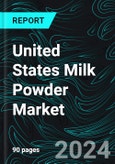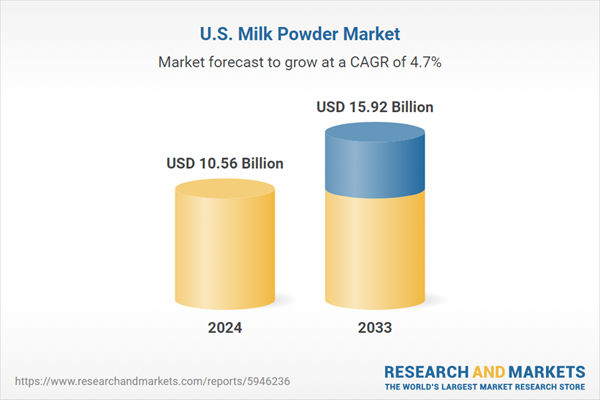The report United States Milk Powder Market & Forecast covers by Type (Whole Milk Powder, Skimmed Milk Powder, Dairy Whitener Powder, Buttermilk Powder, Fat-Filled Milk Powder, Other Milk Powder), Application (Nutritional Food, Infant Formulas, Confectionaries, Baked Sweets, Savories, Others) and Company Analysis 2025-2033.
United States Milk Powder Industry Overview
Evaporation or spray drying are two methods used to remove moisture from pasteurized milk to create milk powder. Its shelf life is increased by this conversion, allowing it to be kept for a longer amount of time without going bad. Consequently, milk powder is used in the culinary sector to make a variety of baked goods and confections.Currently, a number of variables are driving the milk powder industry in the United States. The thickening, gelling, and whipping qualities of milk powder are unique. Because of this, it is used to make delicacies including cakes, mousses, ice cream, and marshmallows. Accordingly, powdered milk is a good source of vitamins A, D, E, and K as well as magnesium, calcium, zinc, and potassium. It is also a staple in drinks, smoothies, puddings, and gravies because of this. Additionally, powdered milk is more portable than liquid milk, which increases demand in the area. In addition, consumers' growing knowledge of the unique nutritional advantages of milk powder has contributed to the market's expansion.
Growth Drivers for the United States Milk Powder Market
Growing baby formula market
A key component of infant formula, a necessary food item for non-breastfed babies, is milk powder. Given its vital function in giving babies the vitamins, minerals, and nutrition they need, the growing infant formula business greatly drives the milk powder market. Rising birth rates, expanding numbers of working moms looking for convenient feeding options, and growing knowledge of the advantages of enriched infant formula are all driving this industry's expansion. The market is supported by the growing demand for premium milk powder as producers work to satisfy the strict quality and nutritional requirements needed for baby nourishment.Growing popularity of dietary supplements
The market for milk powder is greatly impacted by the rise in health consciousness in the US and the need for dietary supplements. A popular element in the creation of these supplements is milk powder, which is high in calcium, protein, and other vital minerals. In order to meet their nutritional demands, preserve their health, and improve their general well-being, consumers are increasingly turning to dietary supplements. Because milk powder is used in protein shakes, bars, and health drinks, this trend is especially noticeable in the fitness and wellness sectors, which fuels demand for the product and, in turn, market expansion.Urbanization and population growth
As the population increases and urbanization quickens, the need for handy, non-perishable food items rises, fueling the US milk powder industry. Food items like milk powder that are easy to store and last a long time are preferred by urban lifestyles, which are defined by hectic schedules and smaller living areas. It provides a useful answer for customers looking for wholesome, easy-to-make solutions that blend in with the hectic pace of the city. The industry is growing because milk powder's longevity and storage effectiveness - which eliminates the need for refrigeration - perfectly match the urban need for food alternatives that are long-lasting and convenient.Challenges in the United States Milk Powder Market
High Competition from Imported Product
The U.S. milk powder business faces a serious threat from competition from imported milk powder goods, especially from nations like the European Union and New Zealand. Because of advantageous agricultural policies, reduced labor costs, and effective production techniques, these areas frequently have lower production costs, which enables them to sell milk powder at more affordable pricing. Because of this, domestic prices are under pressure to decline, which makes it more difficult for American firms to compete without sacrificing margins. The competition may also be heightened by imports' ability to provide a variety of product compositions that appeal to various market categories. In order to lessen the effect of international competition on their market share, this scenario compels American manufacturers to concentrate on increasing product innovation, streamlining operations, or utilizing trade agreements.Environmental Impact
With growing worries about its effects on the environment, sustainability demands are having an increasing impact on the milk powder sector in the United States. Methane emissions from animals, in particular, are a major source of greenhouse gas emissions from the dairy industry. Manufacturers of milk powder are facing pressure to lessen their carbon footprint as governments and consumers call for more environmentally friendly operations. This entails limiting waste, cutting back on water use, and using energy-efficient devices. Furthermore, a significant worry is the effect of transportation on the environment, as it contributes significantly to the carbon emissions of the sector. Making large investments in eco-friendly packaging, sustainable sourcing, and greener production methods may be necessary to meet sustainability targets. Although necessary for long-term sustainability, these adjustments can raise operating expenses and have an impact on profit margins, making it difficult for manufacturers to strike a balance between financial and environmental goals.Skimmed milk powder's low-fat content drives strong demand in the U.S.
Skimmed milk powder is one of the leading segments in the U.S. market. This is because of heightened health consciousness. It caters to the increasing demand for healthier nutritional selections with decreased fat content. Skimmed milk powder is a flexible factor used in numerous food applications, making it a desired option for manufacturers. Besides, its longer shelf life and easy storage contribute to consumer convenience. As fitness-aware traits persist, the recognition of skimmed milk powder continues to push upward, driving its prominence within the market.
Infant formula holds substantial market share due to growing demand
Infant formula commands one of the significant shares of the U.S. milk powder market. This is owed to its essential function in early childhood nutrition. With growing awareness about the importance of proper toddler feeding and increasing numbers of working parents, the demand for toddler formulation remains sturdy. Further, advancements in formulation improvement, consisting of fortified variants catering to specific fitness needs, contribute to its market dominance. Furthermore, stringent regulatory requirements ensure product safety, bolstering consumer consideration. These factors collectively function infant formula as a crucial United States milk powder market section.Type - United States Milk Powder Market breakup in 6 viewpoints:
1. Whole Milk Powder2. Skimmed Milk Powder
3. Dairy Whitener Powder
4. Buttermilk Powder
5. Fat-Filled Milk Powder
6. Other Milk Powder
Application - United States Milk Powder Market breakup in 6 viewpoints:
1. Nutritional Food2. Infant Formulas
3. Confectionaries
4. Baked Sweets
5. Savories
6. Others
All the Key players have been covered from 3 Viewpoints:
- Overview
- Recent Development
- Revenue Analysis
Company Analysis:
1. Dairy Farmers of America Inc.2. Darigold
3. Cargill Corporation
4. The Kraft Heinz Company (U.S)
5. Conagra Brands Inc.
6. Land O'Lakes, Inc.
7. Schreiber Foods Inc.
8. California Dairies Inc.
Table of Contents
Companies Mentioned
- Dairy Farmers of America Inc.
- Darigold
- Cargill Corporation
- The Kraft Heinz Company (U.S)
- Conagra Brands Inc.
- Land O'Lakes, Inc.
- Schreiber Foods Inc.
- California Dairies Inc.
Methodology
In this report, for analyzing the future trends for the studied market during the forecast period, the publisher has incorporated rigorous statistical and econometric methods, further scrutinized by secondary, primary sources and by in-house experts, supported through their extensive data intelligence repository. The market is studied holistically from both demand and supply-side perspectives. This is carried out to analyze both end-user and producer behavior patterns, in the review period, which affects price, demand and consumption trends. As the study demands to analyze the long-term nature of the market, the identification of factors influencing the market is based on the fundamentality of the study market.
Through secondary and primary researches, which largely include interviews with industry participants, reliable statistics, and regional intelligence, are identified and are transformed to quantitative data through data extraction, and further applied for inferential purposes. The publisher's in-house industry experts play an instrumental role in designing analytic tools and models, tailored to the requirements of a particular industry segment. These analytical tools and models sanitize the data & statistics and enhance the accuracy of their recommendations and advice.
Primary Research
The primary purpose of this phase is to extract qualitative information regarding the market from the key industry leaders. The primary research efforts include reaching out to participants through mail, tele-conversations, referrals, professional networks, and face-to-face interactions. The publisher also established professional corporate relations with various companies that allow us greater flexibility for reaching out to industry participants and commentators for interviews and discussions, fulfilling the following functions:
- Validates and improves the data quality and strengthens research proceeds
- Further develop the analyst team’s market understanding and expertise
- Supplies authentic information about market size, share, growth, and forecast
The researcher's primary research interview and discussion panels are typically composed of the most experienced industry members. These participants include, however, are not limited to:
- Chief executives and VPs of leading corporations specific to the industry
- Product and sales managers or country heads; channel partners and top level distributors; banking, investment, and valuation experts
- Key opinion leaders (KOLs)
Secondary Research
The publisher refers to a broad array of industry sources for their secondary research, which typically includes, however, is not limited to:
- Company SEC filings, annual reports, company websites, broker & financial reports, and investor presentations for competitive scenario and shape of the industry
- Patent and regulatory databases for understanding of technical & legal developments
- Scientific and technical writings for product information and related preemptions
- Regional government and statistical databases for macro analysis
- Authentic new articles, webcasts, and other related releases for market evaluation
- Internal and external proprietary databases, key market indicators, and relevant press releases for market estimates and forecasts

LOADING...
Table Information
| Report Attribute | Details |
|---|---|
| No. of Pages | 90 |
| Published | February 2025 |
| Forecast Period | 2024 - 2033 |
| Estimated Market Value ( USD | $ 10.56 Billion |
| Forecasted Market Value ( USD | $ 15.92 Billion |
| Compound Annual Growth Rate | 4.6% |
| Regions Covered | United States |
| No. of Companies Mentioned | 8 |









